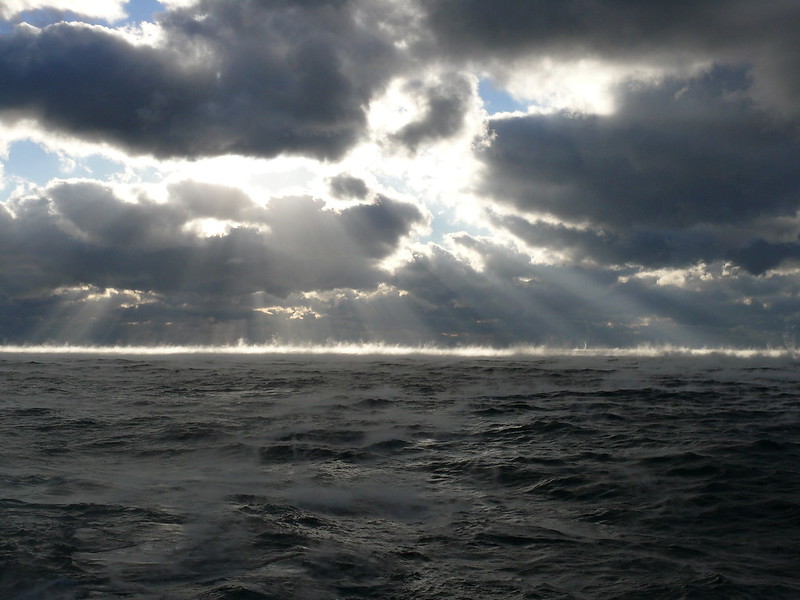The Gulf Stream is one of the most important ocean currents in the world, playing a crucial role in shaping the climate and weather patterns of the North Atlantic region, especially in Europe. Flowing northward from the Gulf of Mexico along the eastern coast of the United States before crossing the Atlantic, the Gulf Stream carries warm, tropical waters that significantly impact regional temperatures and precipitation. The Gulf Stream is not just a natural phenomenon; it is a lifeline that has allowed agriculture to flourish, ecosystems to thrive, and cities across Europe to benefit from relatively mild climates compared to other areas at similar latitudes.
This article offers a comprehensive overview of the Gulf Stream, examining its origins, behavior, and the profound influence it has on European weather. We’ll explore how scientists study this powerful current, how it affects weather systems, and what climate change could mean for its future and, consequently, for Europe’s climate stability.
The Formation and Path of the Gulf Stream
The Gulf Stream is part of a larger circulation system known as the North Atlantic Drift, which is a segment of the global thermohaline circulation. This circulation, often referred to as the “ocean conveyor belt,” is a complex, global system of interconnected ocean currents driven by differences in water temperature and salinity, which affect water density.
1. Origins in the Gulf of Mexico
The Gulf Stream begins in the warm waters of the Gulf of Mexico. Here, the sun heats the surface water, making it less dense than the colder, deeper waters. This warm water flows out of the Gulf and is funneled through the Straits of Florida between Florida and the Bahamas. The initial current created in this region is narrow and fast-moving, known as the Florida Current.
2. Moving North Along the U.S. Coast
Once the Gulf Stream exits the Florida Straits, it becomes a broader, more powerful current as it moves along the eastern coast of the United States. As it flows northward, the Gulf Stream picks up speed and carries an immense amount of heat energy. The current travels at an average speed of about 2.5 meters per second (5.6 miles per hour), with water temperatures ranging from 24°C to 30°C (75°F to 86°F) near the surface. The Gulf Stream flows northeast, hugging the coast of the southeastern U.S. before moving away from the continent near Cape Hatteras, North Carolina.
3. Crossing the Atlantic as the North Atlantic Drift
After moving offshore, the Gulf Stream travels northeast across the Atlantic Ocean, eventually splitting into several branches. One of the primary branches is the North Atlantic Drift, which transports warm water toward Europe. This drift current extends the Gulf Stream’s influence, distributing warm waters across a vast area and directly impacting the climate of Western Europe.
How the Gulf Stream Affects Europe’s Climate
The Gulf Stream’s influence on Europe’s climate is profound, making the continent much warmer and wetter than other regions at similar latitudes. For example, cities such as London, Paris, and Berlin are all situated at latitudes comparable to cities in Canada, such as Calgary or Quebec City. However, Western Europe enjoys much milder winters due to the Gulf Stream, while Canadian cities experience far colder temperatures. This warming effect is crucial for agriculture, biodiversity, and the habitability of European regions that would otherwise be much colder.
1. Temperature Moderation and the Winter Warming Effect
One of the Gulf Stream’s primary impacts on Europe’s weather is temperature moderation, particularly in winter. The warm waters of the North Atlantic Drift bring heat to Western Europe, preventing temperatures from dropping as much as they would without the Gulf Stream. This phenomenon is most evident in coastal regions, such as the British Isles, the western coast of Norway, and parts of France and Spain, where winter temperatures remain relatively mild despite the high latitude.
For instance, the west coast of Norway, warmed by the North Atlantic Drift, remains ice-free year-round, allowing ports such as Bergen to operate even in winter. In contrast, other parts of the world at similar latitudes, like southern Alaska or the eastern coast of Canada, experience severe ice conditions during winter months.
2. Increased Precipitation and Humidity
The warm waters of the Gulf Stream also influence precipitation patterns in Europe. As the warm water travels across the Atlantic, it releases heat into the atmosphere, which raises humidity levels and contributes to cloud formation. This moist air is carried over Europe by prevailing westerly winds, resulting in increased precipitation, especially in coastal areas.
Regions like the United Kingdom, Ireland, and western Norway receive significant rainfall, and much of this moisture can be attributed to the warm air masses created by the Gulf Stream. The western parts of the British Isles, for example, are characterized by lush green landscapes and frequent rainfall, making them starkly different from areas of similar latitude in other parts of the world.
3. Supporting Agriculture and Biodiversity
The Gulf Stream’s warming influence has long supported agriculture and biodiversity in Europe. With a milder winter climate and ample rainfall, regions such as the United Kingdom, Ireland, France, and northern Spain can sustain agricultural practices that would otherwise be challenging at similar latitudes. For example, the temperate climate allows crops such as wheat, barley, and grapes to thrive, supporting local economies and food security.
Additionally, Europe’s biodiversity is shaped by the Gulf Stream’s warmth. Many animal and plant species that are unable to survive in colder climates can thrive in Western Europe. Coastal waters remain relatively warm, creating suitable habitats for marine species such as mackerel, cod, and herring, which support both commercial fisheries and marine ecosystems.
How Scientists Study the Gulf Stream
Understanding the Gulf Stream’s behavior and impact on climate is crucial, particularly in light of ongoing climate change. Scientists use a combination of satellite observations, ocean buoys, and computer models to monitor the Gulf Stream’s flow, temperature, and changes over time.
- Satellite Observations: Satellites provide data on sea surface temperatures, allowing scientists to track the path and strength of the Gulf Stream. They can observe how the warm water moves and shifts over time, which is essential for climate and weather forecasting.
- Ocean Buoys and ARGO Floats: Ocean buoys and ARGO floats measure temperature, salinity, and currents at different depths in the ocean. These instruments provide valuable in situ data, giving researchers insights into the vertical structure and variability of the Gulf Stream.
- Computer Models: Oceanographic and climate models simulate the Gulf Stream’s behavior, allowing scientists to predict how it may change in response to various climate scenarios. By modeling the ocean’s response to factors like greenhouse gas emissions, scientists can assess the potential impact of a weakened Gulf Stream on Europe’s climate.
The Future of the Gulf Stream in a Warming Climate
The Gulf Stream and the broader North Atlantic circulation are driven by the density of seawater, which is influenced by both temperature and salinity. As the planet warms due to climate change, melting ice from Greenland and the Arctic introduces large amounts of freshwater into the North Atlantic, decreasing the salinity and, consequently, the density of the water. This process can slow down the Gulf Stream and potentially disrupt the entire Atlantic Meridional Overturning Circulation (AMOC), of which the Gulf Stream is a part.
1. Potential Weakening of the Gulf Stream
If the Gulf Stream weakens, Europe’s climate would undergo dramatic changes. A weaker Gulf Stream would mean less warm water reaching European shores, leading to colder winters, especially in northern and western Europe. This could result in shorter growing seasons, harsher weather conditions, and decreased agricultural productivity in regions that currently rely on the Gulf Stream for a temperate climate.
2. Increased Weather Extremes
A slowdown in the Gulf Stream could also lead to more extreme weather events. For example, without the moderating influence of the Gulf Stream, Europe may experience harsher winters and warmer summers, leading to greater temperature swings. Additionally, increased storm activity could result as the atmospheric and oceanic currents adjust to the weakened Gulf Stream, creating more frequent and intense rainfall events or even prolonged droughts.
3. Impact on Marine Ecosystems
A weaker Gulf Stream would also have profound effects on marine ecosystems. Cold-water fish species that depend on the Gulf Stream’s warmth might decline, affecting fisheries and the communities that rely on them. Species distribution patterns could shift, as some fish populations move northward to seek colder waters. This shift could disrupt food chains and harm species such as seabirds and marine mammals that depend on fish as a primary food source.
The Gulf Stream and Europe’s Future
The Gulf Stream’s role in shaping Europe’s weather is so critical that any substantial change in its flow or strength could have far-reaching consequences for the continent. As scientists continue to study and monitor the Gulf Stream, it’s clear that protecting this vital current is essential. Efforts to reduce greenhouse gas emissions and address climate change are crucial steps in preserving the stability of the Gulf Stream and, by extension, Europe’s climate.
Public awareness and political action on climate issues can help protect the Gulf Stream from destabilizing. By understanding the Gulf Stream’s influence and advocating for sustainable policies, we can work to ensure that Europe’s temperate climate endures and that future generations can continue to benefit from the life-sustaining warmth of this powerful ocean current.
Conclusion: The Gulf Stream’s Role in Climate and Resilience
The Gulf Stream is more than just an ocean current; it is a vital system that affects weather, ecosystems, and human livelihoods across the North Atlantic and Europe. From keeping European winters milder to supporting biodiversity and agriculture, the Gulf Stream’s impact on Europe’s climate cannot be overstated. As our planet faces the challenges of climate change, understanding and preserving this crucial oceanic feature is essential for the future stability of Europe’s environment, economy, and culture.
Through continued research, responsible environmental practices, and climate-conscious policies, we can protect the Gulf Stream and the benefits it provides, ensuring that this remarkable ocean current continues to be a defining force in European weather and climate.



